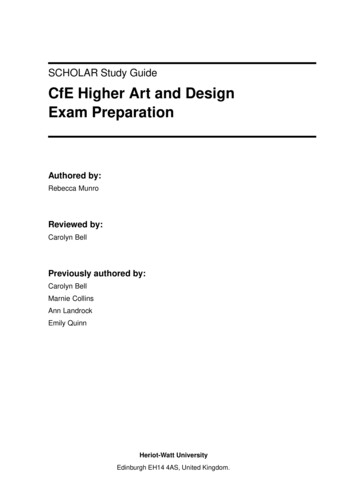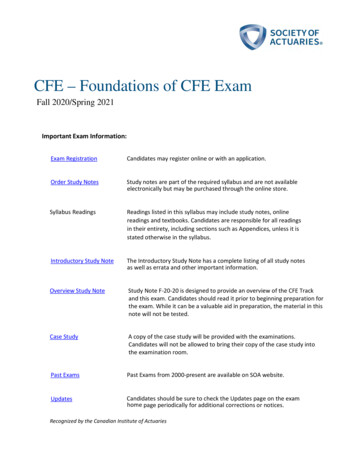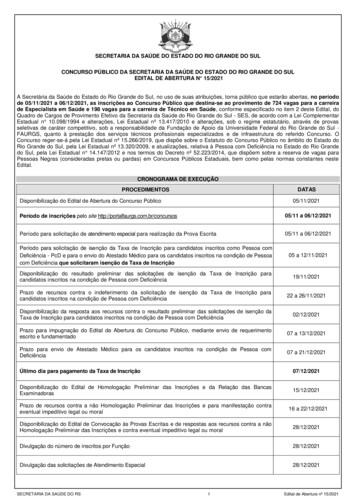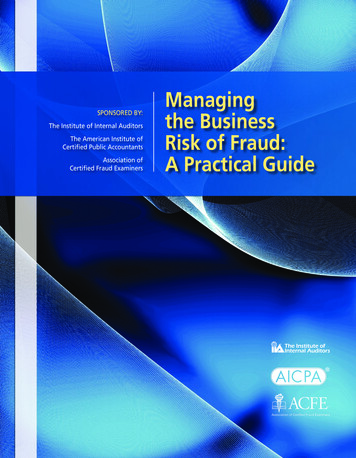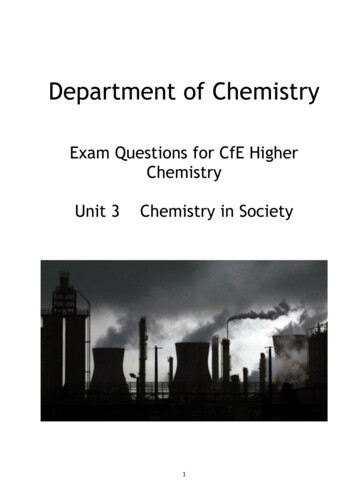
Transcription
Department of ChemistryExam Questions for CfE HigherChemistryUnit 3Chemistry in Society1
3.1 Getting the Most from Reactants1. How many moles of oxygen atoms are in 0.5 mol of carbon dioxide?A 0.25B 0.5C1D22. A fullerene molecule consists of 60 carbon atoms.Approximately how many such molecules are present in 12 g of this type of carbon?A 1.0 1022B 1.2 1023C 6.0 1023D 3.6 10253. Which of the following gases would contain the greatest number of molecules in a 100 gsample, at room temperature?A FluorineB HydrogenC NitrogenD Oxygen4. A mixture of potassium chloride and potassium carbonate is known to contain0·1 mol of chloride ions and 0·1 mol of carbonate ions. How many moles of potassiumions are present?A 0·15B 0·20C 0·25D 0·305. The mass of 1 mol of sodium is 23 g. What is the approximate mass of one sodiumatom?A 6 1023 gB 6 10–23 gC 3.8 10–23 gD 3.8 10–24 g6. Which of the following gas samples has the same volume as 7 g of carbon monoxide?(All volumes are measured at the same temperature and pressure.)A 1 g of hydrogenB 3.5 g of nitrogenC 10 g of argonD 35 . 5 g of chlorine2
7. In which of the following pairs do the gases contain the same number of oxygen atoms?A 1 mol of oxygen and 1 mol of carbon monoxideB 1 mol of oxygen and 0.5 mol of carbon dioxideC 0.5 mol of oxygen and 1 mol of carbon dioxideD 1 mol of oxygen and 1 mol of carbon dioxide8. The Avogadro Constant is the same as the number ofA molecules in 16 g of oxygenB ions in 1 litre of sodium chloride solution, concentration 1 mol l–1C atoms in 24 g of carbonD molecules in 2 g of hydrogen.9. Which of the following contains one mole of neutrons?10. The Avogadro Constant is the same as the number ofA ions in 1 mol of NaClB atoms in 1 mol of hydrogen gasC electrons in 1 mol of helium gasD molecules in 1 mol of oxygen gas.11. The Avogadro Constant is the same as the number ofA molecules in 16 g of oxygenB electrons in 1 g of hydrogenC atoms in 24 g of carbonD ions in 1 litre of sodium chloride solution, concentration 1 mol l–1.12. Avogadro‟s Constant is the same as the number ofA molecules in 16.0 g of oxygenB atoms in 20.2 g of neonC formula units in 20.0 g of sodium hydroxideD ions in 58.5 g of sodium chloride.13. Which of the following has the largest volume under the same conditions of temperatureand pressure?A 1 g hydrogenB 14 g nitrogenC 20·2 g neonD 35·5 g chlorine3
14. The equation for the complete combustion of propane is:C3H8(g) 5O2(g) 3CO2(g) 4H2O(l)30cm3 of propane is mixed with 200cm3 of oxygen and the mixture is ignited. What is thevolume of the resulting gas mixture? (All volumes are measured at the sametemperature and pressure.)A 90cm3B 120cm3C 140cm3D 210cm315. 20cm3 of butane is burned in 150 cm3 of oxygen.C4H10(g) 6O2(g) 4CO2(g) 5H2O(g)What is the total volume of gas present after complete combustion of the butane?A 80cm3B 100cm3C 180cm3D 200cm316. 2NO(g) O2(g) 2NO2(g)How many litres of nitrogen dioxide gas could theoretically be obtained in the reactionof 1 litre of nitrogen monoxide gas with 2 litres of oxygen gas? (All volumes aremeasured under the same conditions of temperature and pressure.)A1B2C3D417. 2NO(g) O2(g) 2NO2(g)How many litres of nitrogen dioxide gas would be produced in a reaction, starting witha mixture of 5 litres of nitrogen monoxide gas and 2 litres of oxygen gas? (All volumesare measured under the same conditions of temperature and pressure.)A2B3C4D518. What volume of oxygen (in litres) would be required for the complete combustion of agaseous mixture containing 1 litre of carbon monoxide and 3 litres of hydrogen?(All volumes are measured at the same temperature and pressure.)A1B2C3D44
19. 2C2H2(g) 5O2(g) 4CO2(g) 2H2O(l)ethyneWhat volume of gas would be produced by the complete combustion of 100 cm3 ofethyne gas? All volumes were measured at atmospheric pressure and room temperature.A 200 cm3B 300 cm3C 400 cm3D 800 cm320. 20cm3 of ammonia gas reacted with an excess of heated copper(II) oxide.3CuO 2NH3 3Cu 3H2O N2Assuming all measurements were made at 200 C, what would be the volume of gaseousproducts?A 10cm3B 20cm3C 30cm3D 40cm321. Calcium carbonate reacts with nitric acid as follows.CaCO3(s) 2HNO3(aq) Ca(NO3)2(aq) H2O(l) CO2(g)0·05 mol of calcium carbonate was added to a solution containing 0·08 mol of nitricacid. Which of the following statements is true?A 0·05 mol of carbon dioxide is produced.B 0·08 mol of calcium nitrate is produced.C Calcium carbonate is in excess by 0·01 mol.D Nitric acid is in excess by 0·03 mol.22. A mixture of magnesium bromide and magnesium sulfate is known to contain 3 molof magnesium and 4 mol of bromide ions. How many moles of sulfate ions are present?A1B2C3D423. 5 g of copper is added to excess silver nitrate solution. The equation for the reactionthat takes place is:After some time, the solid present is filtered off from the solution, washed with water,dried and weighed. The final mass of the solid will beA less than 5 gB 5gC 10gD more than 10 g.5
24. A pupil added 0·1 mol of zinc to a solution containing 0·05 mol of silver(I) nitrate.Zn(s) 2AgNO3(aq) Zn(NO3)2(aq) 2Ag(s)Which of the following statements about the experiment is correct?A 0·05 mol of zinc reacts.B 0·05 mol of silver is displaced.C Silver nitrate is in excess.D All of the zinc reacts.25. 0·5 mol of copper(II) chloride and 0·5 mol of copper(II) sulphate are dissolved togetherin water and made up to 500 cm3 of solution. What is the concentration of Cu2 (aq) ionsin the solution in mol l–1?A 0·5B 1·0C 2·0D 4·026. 10 g of magnesium is added to 1 litre of 1 mol l–1 copper(II) sulphate solution and themixture stirred until the reaction is complete. Which of these is a result of this reaction?A All the magnesium reacts.B 63 . 5 g of copper is displaced.C 2 mol of copper is displaced.D The resulting solution is colourless.27. Ammonia is manufactured from hydrogen and nitrogen by the Haber Process.3H2(g) N2(g)2NH3(g)If 80 kg of ammonia is produced from 60 kg of hydrogen, what is the percentage yield?28. Two identical samples of copper(II) carbonate were added to an excess of 1 mol l–1hydrochloric acid and 1 mol l–1 sulphuric acid respectively.Which of the following would have been different for the two reactions?A The pH of the final solutionB The volume of gas producedC The mass of water formedD The mass of copper(II) carbonate dissolved29. Which of the following is the best description of a feedstock?A A consumer product such as a textile, plastic or detergent.B A complex chemical that has been synthesised from small molecules.C A mixture of chemicals formed by the cracking of the naphtha fraction from oil.D A chemical from which other chemicals can be extracted or synthesised.6
30. Which of the following compounds is a raw material in the chemical industry?A AmmoniaB Calcium carbonateC HexaneD Nitric acid31. The mean bond enthalpy of the N H bond is equal to one third of the value of ΔH forwhich change?32. Ammonia is made by the Haber Process.N2(g) 3H2(g)2NH3(g)The equilibrium position lies to the left. Which line in the table is correct?33. The flow chart summarises some industrial processes involving ethene.The feedstocks for ethene in these processes areA ethane and glycolB ethane and ethanolC glycol and poly(ethene)D glycol, poly(ethene) and ethanol.7
34. Polylactic acid is used to make a biodegradable polymer. Polylactic acid can bemanufactured by either a batch or a continuous process. What is meant by a batchprocess? (1)35. Magnesium metal can be extracted from sea water.An outline of the reactions involved is shown in the flow diagram.(a) Why can the magnesium hydroxide be easily separated from the calcium chloride atStage 1? (1)(b) Name the type of chemical reaction taking place at Stage 2. (1)(c) Give two different features of this process that make it economical. (2)8
36. Cerium metal is extracted from the mineral monazite.The flow diagram for the extraction of cerium from the mineral is shown below.(a) Name the type of chemical reaction taking place in Step A. (1)(b) In Step B, cerium hydroxide is heated to form cerium oxide, Ce2O3, and compound Z.Name compound Z. (1)(c) In Step C, cerium metal is obtained by electrolysis. What feature of the electrolysiscan be used to reduce the cost of cerium production? (1)37. Ozone can be produced in the laboratory by electrical discharge.3O2(g) 2O3(g)Calculate the approximate number of O3(g) molecules produced from one mole of O2(g)molecules. (1)9
38. Chlorine gas can be produced by heating calcium hypochlorite, Ca(OCl)2, in dilutehydrochloric acid.Ca(OCl)2(s) 2HCl(aq) Ca(OH)2(aq) 2Cl2(g)Calculate the mass of calcium hypochlorite that would be needed to produce 0·096 litresof chlorine gas. (Take the molar volume of chlorine gas to be 24 litres mol–1.)Show your working clearly. (2)39. A student bubbled 240 cm3 of carbon dioxide into 400cm3 of 0.10 mol l–1 lithiumhydroxide solution.The equation for the reaction is:2LiOH(aq) CO2(g) Li2CO3(aq) H2O(l)Calculate the number of moles of lithium hydroxide that would not have reacted.(Take the molar volume of carbon dioxide to be 24 litres mol–1.)Show your working clearly. (2)40. (a) In the lab, nitrogen dioxide gas can be prepared by heating copper(II) nitrate.Cu(NO3)2(s) CuO(s) 2NO2(g) ½ O2(g)Calculate the volume of nitrogen dioxide gas produced when 2.0g of copper(II)nitrate is completely decomposed on heating. (Take the molar volume of nitrogendioxide to be 24 litres mol–1.) Show your working clearly. (2)(b) Nitrogen dioxide has a boiling point of 22 C. Complete the diagram to show hownitrogen dioxide can be separated and collected. (1)41. Sherbet contains a mixture of sodium hydrogencarbonate and tartaric acid. Thefizzing sensation in the mouth is due to the carbon dioxide produced in thefollowing reaction.In an experiment, a student found that adding water to 20 sherbet sweets produced105 cm3 of carbon dioxide. Assuming that sodium hydrogencarbonate is in excess,calculate the average mass of tartaric acid, in grams, in one sweet.(Take the molar volume of carbon dioxide to be 24 litre mol–1.)Show your working clearly. (2)10
42. The nutritional information states that 100 g of margarine contains 0.70 g of sodium.The sodium is present as sodium chloride (NaCl). Calculate the mass of sodium chloride,in g, present in every 100 g of margarine. (1)43. Hydrogen fluoride gas is manufactured by reacting calcium fluoride with concentratedsulphuric acid.CaF2 H2SO4 CaSO4 2HFWhat volume of hydrogen fluoride gas is produced when 1.0 kg of calcium fluoride reactscompletely with concentrated sulphuric acid?(Take the molar volume of hydrogen fluoride gas to be 24 litres mol–1.)Show your working clearly. (2)44. Methanamide, HCONH2, is widely used in industry to make nitrogen compounds.It is also used as a solvent as it can dissolve ionic compounds.(a) Why is methanamide a suitable solvent for ionic compounds? (1)(b) In industry, methanamide is produced by the reaction of an ester with ammonia.(i) Name the ester used in the industrial manufacture of methanamide. (1)(ii) Calculate the atom economy for the production of methanamide. (1)(c) In the lab, methanamide can be prepared by the reaction of methanoic acidwith ammonia.When 1·38 g of methanoic acid was reacted with excess ammonia, 0·945 g ofmethanamide was produced. Calculate the percentage yield of methanamide. Showyour working clearly. (2)11
45. Aspirin, a common pain-killer, can be made by the reaction of salicylic acid withethanoic anhydride.(a) Calculate the atom economy for the formation of aspirin using this method.Show your working clearly. (2)(b) In a laboratory preparation of aspirin, 5·02 g of salicylic acid produced 2·62 gof aspirin. Calculate the percentage yield of aspirin. Show your working clearly. (2)46. From the 1990s, ibuprofen has been synthesised by a three step process. The equationbelow shows the final step of the synthesis.What is the atom economy of this step? (1)47. One of the chemicals released in a bee sting is an ester that has the structure shown.This ester can be produced by the reaction of 2-methylbutan-1-ol with ethanoic acid.If there is a 65% yield, calculate the mass of ester produced, in grams, when 4.0 g of thealcohol reacts with a slight excess of the acid.(Mass of one mole of the alcohol 88 g; mass of one mole of the ester 130 g)Show your working clearly. (2)12
48. Ammonia is produced in industry by the Haber Process.N2(g) 3H2(g)2NH3(g)Under certain conditions, 500 kg of nitrogen reacts with excess hydrogen to produce405 kg of ammonia. Calculate the percentage yield of ammonia under these conditions.Show your working clearly. (2)49. Ethane-1,2-diol is produced in industry by reacting glycerol with hydrogen.Excess hydrogen reacts with 27·6 kg of glycerol to produce 13·4 kg of ethane-1,2-diol.Calculate the percentage yield of ethane-1,2-diol. Show your working clearly. (2)50. Sulphur trioxide can be prepared in the laboratory by the reaction of sulphur dioxidewith oxygen.2SO2(g) O2(g)2SO3(g)The sulphur dioxide and oxygen gases are dried by bubbling them through concentratedsulphuric acid. The reaction mixture is passed over heated vanadium(V) oxide.Sulphur trioxide has a melting point of 17 C. It is collected as a white crystalline solid.(a) Complete the diagram to show how the reactant gases are dried and the product iscollected. (2)(b) Under certain conditions, 43·2 tonnes of sulphur trioxide are produced in thereaction of 51·2 tonnes of sulphur dioxide with excess oxygen. Calculate thepercentage yield of sulphur trioxide. Show your working clearly. (2)13
3.2 Equilibria1. A catalyst is used in the Haber Process.N2(g) 3H2(g)2NH3(g)Which of the following best describes the action of the catalyst?A Increases the rate of the forward reaction onlyB Increases the rate of the reverse reaction onlyC Increases the rate of both the forward and reverse reactionsD Changes the position of the equilibrium of the reaction2. In which of the following systems will the equilibrium be unaffected by a change inpressure?A 2NO2(g)N2O4(g)B H2(g) I2(g)2HI(g)C N2(g) 3H2(g)2NH3(g)D 2NO(g) O2(g)2NO2(g)3. A few drops of concentrated sulphuric acid were added to a mixture of 0·1 mol ofmethanol and 0·2 mol of ethanoic acid. Even after a considerable time, the reactionmixture was found to contain some of each reactant. Which of the following is the bestexplanation for the incomplete reaction?A The temperature was too low.B An equilibrium mixture was formed.C Insufficient methanol was used.D Insufficient ethanoic acid was used.4. Which line in the table shows the effect of a catalyst on the reaction rates and position ofequilibrium in a reversible reaction?5. The following equilibrium exists in bromine water.The red colour of bromine water would fade on adding a few drops of a concentratedsolution ofA HClB KBrC AgNO3D NaOBr.14
6. A catalyst is added to a reaction at equilibrium. Which of the following does not apply?A The rate of the forward reaction increases.B The rate of the reverse reaction increases.C The position of equilibrium remains unchanged.D The position of equilibrium shifts to the right.7. In which of the following reactions woulD an increase in pressure cause the equilibriumposition to move to the left?8. If ammonia is added to a solution containing copper(II) ions an equilibrium is set up.Cu2 (aq) 2OH–(aq) 4NH3(aq)Cu(NH3)4(OH)2(aq)(deep blue)If acid is added to this equilibrium systemA the intensity of the deep blue colour will increaseB the equilibrium position will move to the rightC the concentration of Cu2 (aq) ions will increaseD the equilibrium position will not be affected.9. Steam and carbon monoxide react to form an equilibrium mixture.CO(g) H2O(g)H2(g) CO2(g)Which of the following graphs shows how the rates of the forward and reverse reactionschange when carbon monoxide and steam are mixed?15
10. 2SO2(g) O2(g)2SO3(g)The equation represents a mixture at equilibrium. Which line in the table is true for themixture after a further 2 hours of reaction?11. In which of the following would an increase in pressure result in the equilibrium positionbeing moved to the left?12. Nitrogen dioxide gas can be prepared in different ways. It is manufactured industriallyas part of the Ostwald process. In the first stage of the process, nitrogen monoxide isproduced by passing ammonia and oxygen over a platinum catalyst.NH3(g) O2(g) NO(g) H2O(g)(a) Balance the above equation. (1)(b) Platinum metal is a heterogeneous catalyst for this reaction. What is meant by aheterogeneous catalyst? (1)(c) The nitrogen monoxide then combines with oxygen in an exothermic reaction to formnitrogen dioxide.2NO(g) O2(g)2NO2(g)What happens to the yield of nitrogen dioxide gas if the reaction mixture is cooled?(1)13. Atmospheric oxygen, O2(g), dissolves in the Earth‟s oceans forming dissolved oxygen,O2(aq), which is essential for aquatic life. An equilibrium is established.O2(g) (aq)O2(aq)ΔH –12·1 kJ mol–1(a) (i) What is meant by a reaction at “equilibrium”?(ii) What would happen to the concentration of dissolved oxygen if the temperatureof the Earth‟s oceans increased?(b) A sample of oceanic water was found to contain 0·010 g of dissolved oxygen.Calculate the number of moles of dissolved oxygen present in the sample. (1)16
14. When cyclopropane gas is heated over a catalyst, it isomerises to form propene gas andan equilibrium is obtained.The graph shows the concentrations of cyclopropane and propene as equilibrium isestablished in the reaction.(a) Mark clearly on the graph the point at which equilibrium has just been reached. (1)(b) Why does increasing the pressure have no effect on the position of this equilibrium?(1)(c) The equilibrium can also be achieved by starting with propene.Using the initial concentrations shown, sketch a graph to show how the concentrationsof propene and cyclopropane change as equilibrium is reached for the reverse reaction(1)17
15. Tetrafluoroethene, C2F4, is produced in industry by a series of reactions. The finalreaction in its manufacture is shown below.2CHClF2(g)C2F4(g) 2HCl(g)The graph shows the variation in concentration of C2F4 formed as temperature isincreased.(a) What conclusion can be drawn about the enthalpy change for the formation oftetrafluoroethene? (1)(b) Sketch a graph to show how the concentration of tetrafluoroethene formed wouldvary with increasing pressure. (1)18
16. Ammonia is produced in industry by the Haber Process.N2(g) 3H2(g)2NH3(g)(a) State whether the industrial manufacture of ammonia is likely to be a batch or acontinuous process. (1)(b) The graph shows how the percentage yield of ammonia changes with temperature ata pressure of 100 atmospheres.(i) A student correctly concludes from the graph that the production of ammonia is anexothermic process. What is the reasoning that leads to this conclusion? (1)(ii) Explain clearly why the industrial manufacture of ammonia is carried out at apressure greater than 100 atmospheres. (2)17. Rivers and drains are carefully monitored to ensure that they remain uncontaminated bypotentially harmful substances from nearby industries. Chromate ions, CrO42–, areparticularly hazardous.When chromate ions dissolve in water the following equilibrium is established.2CrO42–(aq) 2H (aq)Cr2O7 2–(aq) H2O(l)yelloworangeExplain fully the colour change that would be observed when solid sodium hydroxide isadded to the solution. (2)19
3.3 Chemical Energy1. Which of the following represents an exothermic process?A Cl2(g) 2Cl(g)B Na(s) Na(g)C Na(g) Na (g) e–D Na (g) Cl–(g) Na Cl–(s)2. Which of the following equations represents an enthalpy of combustion?3. The enthalpy of combustion of methanol is –727 kJ mol–1. What mass of methanol has tobe burned to produce 72·7 kJ?A 3·2 gB 32·0 gC 72·7 gD 727·0 g4. 5N2O4(l) 4CH3NHNH2(l) 4CO2(g) 12H2O(l) 9N2(g) ΔH 5116 kJThe energy released when 2 moles of each reactant are mixed and ignited isA 2046 kJB 2558 kJC 4093 kJD 5116 kJ.5. Aluminium reacts with oxygen to form aluminium oxide.2Al(s) 1½O2(g) Al2O3(s)ΔH 1670 kJ mol 1What is the enthalpy of combustion of aluminium in kJ mol 1?A 835B 1113C 1670D 167020
6.What is the relationship between a, b, c and d?Aa b c–dBa d–b–cCa b–c–dDa d c–b7. Given the equationsthen, according to Hess‟s LawAc a–bBc a bCc b–aD c – b – a.8.What is the relationship between a, b, c and d?Aa c d bBa b c dC a b c dDa c b d9. In the presence of bright light, hydrogen and chlorine react explosively. One step in thereaction is shown below.H2(g) Cl(g) HCl(g) H(g)The enthalpy change for this step can be represented asA (H-H bond enthalpy) (Cl-Cl bond enthalpy)B (H-H bond enthalpy) (Cl-Cl bond enthalpy)C (H-H bond enthalpy) (H-Cl bond enthalpy)D (H-H bond enthalpy) (H-Cl bond enthalpy).21
10. The energy changes taking place during chemical reactions have many everyday uses.(a) Some portable cold packs make use of the temperature drop that takes place whenthe chemicals in the pack dissolve in water.Name the type of reaction that results in a fall in temperature. (1)(b) Flameless heaters are used by mountain climbers to heat food and drinks. Thechemical reaction in a flameless heater releases 45 kJ of energy. If 200 g of water isheated using this heater, calculate the rise in temperature of the water, in C. (1)11. The compound diborane (B2H6) is used as a rocket fuel.(a) It can be prepared as shown.BF3 NaBH4 B2H6 NaBF4Balance this equation. (1)(b) The equation for the combustion of diborane is shown below.B2H6(g) 3O2(g) B2O3(s) 3H2O(l)Calculate the enthalpy of combustion of diborane (B2H6) in kJ mol 1, using thefollowing data. (2)12. Hydrogen peroxide decomposes as shown:H2O2(aq) H2O(l) ½ O2(g)The reaction can be catalysed by iron(III) nitrate solution.(a) What type of catalyst is iron(III) nitrate solution in this reaction? (1)(b) In order to calculate the enthalpy change for the decomposition of hydrogenperoxide, a student added iron(III) nitrate solution to hydrogen peroxide solution.As a result of the reaction, the temperature of the solution in the polystyrene beakerincreased by 16 C.(i) What is the effect of the catalyst on the enthalpy change (ΔH) for the reaction? (1)(ii) Use the experimental data to calculate the enthalpy change, in kJ mol–1, for thedecomposition of hydrogen peroxide. Show your working clearly. (3)22
13. A student used the simple laboratory apparatus shown to determine the enthalpy ofcombustion of methanol.(a) (i) What measurements are needed to calculate the energy released by the burningmethanol? (1)(ii) The student found that burning 0.370 g of methanol produces 3.86 kJ of energy.Use this result to calculate the enthalpy of combustion of methanol. (1)(b) A more accurate value can be obtained using a bomb calorimeter.One reason for the more accurate value is that less heat is lost to the surroundings thanin the simple laboratory method. Give one other reason for the value being moreaccurate in the bomb calorimeter method. (1)14. Mobile phones are being developed that can be powered by methanol. Methanol can bemade by a two-stage process.In the first stage, methane is reacted with steam to produce a mixture of carbonmonoxide and hydrogen.CH4(g) H2O(g)CO(g) 3H2(g)Use the data below to calculate the enthalpy change, in kJ mol–1, for the forwardreaction.Show your working clearly. (2)23
15. The enthalpies of combustion of some alcohols are shown in the table.(a) Using this data, predict the enthalpy of combustion of butan-1-ol, in kJ mol–1. (1)(b) A value for the enthalpy of combustion of butan-2-ol, C4H9OH, can be determinedexperimentally using the apparatus shown.Mass of butan-2-ol burned 1·0 gTemperature rise of water 40 CUse these results to calculate the enthalpy of combustion of butan-2-ol, in kJ mol–1.(2)(c) Enthalpy changes can also be calculated using Hess‟s Law. The enthalpy of formationfor pentan-1-ol is shown below.5C(s) 6H2(g) ½ O2(g) C5H11OH(l)ΔH –354 kJ mol–1Using this value, and the enthalpies of combustion of carbon and hydrogen from thedata booklet, calculate the enthalpy of combustion of pentan-1-ol, in kJ mol–1. (2)24
16. Different fuels are used for different purposes.(a) Ethanol, C2H5OH, can be used as a fuel in some camping stoves.(i) The enthalpy of combustion of ethanol given in the data booklet is 1367 kJ mol 1. Using this value, calculate the mass of ethanol, in g, required toraise the temperature of 500 g of water from 18 C to 100 C. Show yourworking clearly. (3)(ii) Suggest two reasons why less energy is obtained from burning ethanol in thecamping stove than is predicted from its enthalpy of combustion. (2)(b) Petrol is a fuel used in cars.A car has a 50·0 litre petrol tank. Calculate the energy, in kJ, released by thecomplete combustion of one tank of petrol. (2)17. Hydrogen has been named as a „fuel for the future‟. In a recent article researchersreported success in making hydrogen from glycerol:C3H8O3(l) CO2(g) CH4(g) H2(g)(a) Balance this equation. (1)(b) The enthalpy of formation of glycerol is the enthalpy change for the reaction:3C(s) 4H2(g) 1½O2(g) C3H8O3(l)(graphite)Calculate the enthalpy of formation of glycerol, in kJ mol–1, using information fromthe data booklet and the following data.C3H8O3(l) 3½O2(g) 3CO2(g) 4H2O(l)ΔH –1654 kJ mol–1Show your working clearly. (2)18. The equation for the enthalpy of formation of ethyne is:2C(s) H2(g) C2H2(g)Use the enthalpies of combustion of carbon, hydrogen and ethyne given in the databooklet to calculate the enthalpy of formation of ethyne, in kJ mol–1. Show your workingclearly. (2)25
19. Chloromethane can be produced by the reaction of methane with chlorine.CH4(g) Cl2(g) CH3Cl(g) HCl(g)Using bond enthalpies from the data booklet, calculate the enthalpy change, inkJ mol 1, for this reaction. (2)20. The production of hydrogen chloride from hydrogen and chlorine is exothermic.H2(g) Cl2(g) 2HCl(g)Using bond enthalpy values, calculate the enthalpy change, in kJ mol-1, for this reaction.(2)21. When in danger, bombardier beetles can fire a hot, toxic mixture of chemicals at theattacker. This mixture contains quinone, C6H4O2, a compound that is formed by thereaction of hydroquinone, C6H4(OH)2, with hydrogen peroxide, H2O2. The reaction iscatalysed by an enzyme called catalase.(a) Most enzymes can catalyse only specific reactions, eg catalase cannot catalyse thehydrolysis of starch. Give a reason for this. (1)(b) The equation for the overall reaction is:C6H4(OH)2(aq) H2O2(aq) C6H4O2(aq) 2H2O(l)Use the following data to calculate the enthalpy change, in kJ mol–1, for the abovereaction.C6H4(OH)2(aq) C6H4O2(aq) H2(g)ΔH 177.4 kJ mol–1H2(g) O2(g) H2O2(aq)ΔH –191.2 kJ mol–1H2(g) ½ O2(g) H2O(g)ΔH –241.8 kJ mol–1H2O(g) H2O(l)ΔH –43.8 kJ mol–1Show your working clearly. (2)22. (a) Methane is produced in the reaction of aluminium carbide with water.Al4C3 H2O Al(OH)3 CH4Balance the above equation. (1)(b) Silane, silicon hydride, is formed in the reaction of silicon with hydrogen.Si(s) 2H2(g) SiH4(g)silaneThe enthalpy change for this reaction is called the enthalpy of formation of silane.The combustion of silane gives silicon dioxide and water.SiH4(g) 2O2(g) SiO2(s) 2H2O(l)ΔH –1517 kJ mol–1The enthalpy of combustion of silicon is –911 kJ mol–1.Use this information and the enthalpy of combustion of hydrogen in the data bookletto calculate the enthalpy of formation of silane, in kJ mol–1. Show your workingclearly. (2)26
23. (a) Hess‟s Law can be verified using the reactions summarised below.(i) Complete the list of measurements that would have to be carried out in order todetermine the enthalpy change for Reaction 2. (1)(ii) Why was the reaction carried out in a polystyrene cup? (1)(iii) A student found that 1·08kJ of energy was released when 1·2 g of potassiumhydroxide was dissolved completely in water. Calculate the enthalpy of solution ofpotassium hydroxide. (1)(b) A student wrote the following incorrect statement.The enthalpy of neutralisation for hydrochloric acid reacting with potassiumhydroxide is less than that for sulphuric acid reacting with potassium hydroxidebecause fewer moles of water are formed as shown in these equations.HCl KOH KCl H2OH2SO4 2KOH K2SO4 2H2OExplain the mistake in the student‟s statement. (1)27
3.4 Oxidising or Reducing Agents1. The iodate ion, IO3–, can be converted to iodine.Which is the correct ion-electron equation for the reaction?A 2IO3–(aq) 12H (aq) 12e– 2I–(aq) 6H2O(l)B IO3–(aq) 6H (aq) 7e– I–(aq) 3H2O(l)C 2IO3–(aq) 12H (aq) 11e– I2(aq) 6H2O(l)D 2IO3–(aq) 12H (aq) 10e– I2(aq) 6H2O(l)2. Which of the following is a redox reaction?A Mg 2HCl MgCl2 H2B MgO 2HCl MgCl2 H2OC MgCO3 2HCl MgCl2 H2O CO2D Mg(OH)2 2HCl MgCl2 2H2O3. The ion-electron equations for a redox reaction are:How many moles of iodide ions are oxidized by one mole of permanganate ions?A 0.2B 0.4C2D54. In which of the following reactions is the hydrogen ion acting as an oxidising agent?5. During a redox process in acid solution, iodate ions IO3 (aq) are converted into iodine I2(aq).IO3 (aq) I2(aq)The numbers of H (aq) and H2O(l) required to balance the ion-electron equation for theformation of 1 mol of I2(aq) are, respectivelyA 3 and 6B 6 and 3C 6 and 12D 12 and 6.6. In which of the following reactions is a positive ion reduced?A Iodide iodineB Nickel(II) nickel(III)C Cobalt(III) cobalt(II)D Sulphate sulphite28
7. In which reaction is hydrogen gas acting as an oxidising agent?A H2 CuO H2O CuB H2 C2H4 C2H6C H2 Cl2 2HClD H2 2Na 2NaH8. Iodide ions can be oxidised using acid
Exam Questions for CfE Higher Chemistry Unit 3 Chemistry in Society . 2 3.1 Getting the Most from Reactants 1. How many moles of oxygen atoms are in 0.5 mol of carbon dioxide? A 0.25 B 0.5 C 1 D 2 2. A fullerene molecule consists of 60 carbon atoms.



